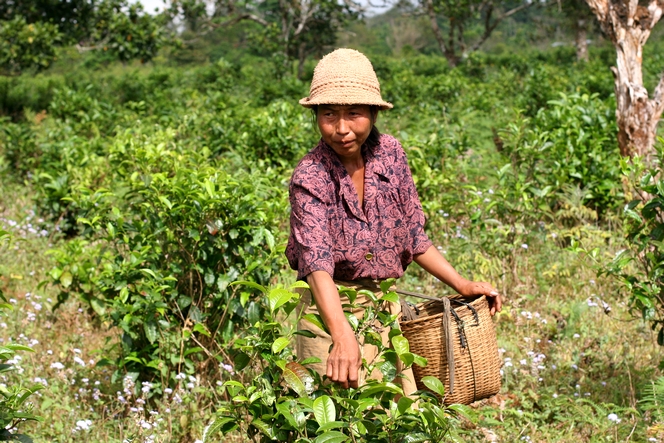Having travelled around the region where Pu Er is grown, I moved further south, to Laos. There, I discovered, halfway between Paksé and Paksong, on the Boloven plateau, a small-scale factory making a very good black tea with aromas of cooked fruits, leather and spices, which will delight fans of Grand Yunnan Imperial.
Curiously, the tea plants here grow in the middle of coffee plantations. In fact, to enable the local rural population, who earn very little, to generate some extra income, the Lao Farmers Association has taught them how to grow tea, and has opened a cooperative whose purpose is to support the community rather than to make a profit.
As I walked for a few hours among the tea plants and luxuriant vegetation, I noticed two things in particular: the bomb craters left by the Vietnam war, and also the incredible number of leeches you must pull off as you walk. Not only do they climb up your shoes and trousers, but the creatures even manage to drop out of the sky, or rather, the trees, and land all over you, even in the palm of your hand.






Hello Mr. Delmas,
Very interesting post! Thank you for sharing. I’d like to visit this plantation very much at the end on March. Hoping to buy some black Pu erh from Lao- are there many Pu erh growers in the country? Any USDA organics? Traveling from Ho Chi Minh City, how would you recommend getting there in the shortest amount of time. Only have about 3 days of total time.
Any insight about anything Lao Puerh Tea related would be much appreciated!
Chris
Hi Chris !
I’m sorry to tell you that they stopped producing such tea now. I don’t know for how long time exactly. It is due to different reasons but among them some dispute between share holders of the factory. So no need to visit there now. By the way it was near Paksong. But for Pu Er the area is at the northest of Laos, at the board with China. And that tea goes to China.
Enjoy !
Hello francois,
Have I read there that this tea is no longer produced? I purchased some last year from palais du thes in Paris and was thinking about buying more. Having visited Laos I found it a charming country and that led my decision to buy some, cemented by the taste! It would be a shame for this delicious tea to fall by the wayside. Maybe I should head over there and set it up again!
Regards
Angus.
Dear Angus, that’s a great idea. It’s a pity we can’t find today same tea as last year. I’ve been to Laos recently to meet producers but cooperative is closed now due to many reasons, mostly disagrement between different people. Will keep you updated of course, via my blog.
30 years ago I was posted in Laos and regularly had a tea which when brewed was yellow to orange, with no additive or coloring. It was also creamy. In French avec du corps. I was in Laos last week and could not find it. In fact nobody knew it. Have you seen it or tasted it? Would you know its lao name? It was excellent and taken without milk or sugar. Many thanks